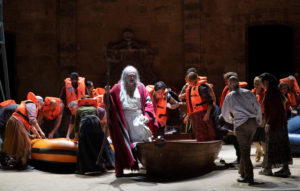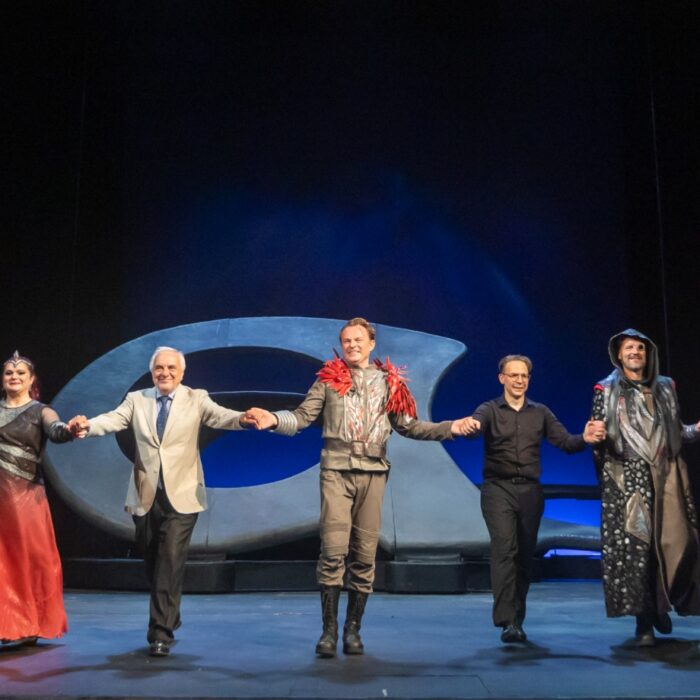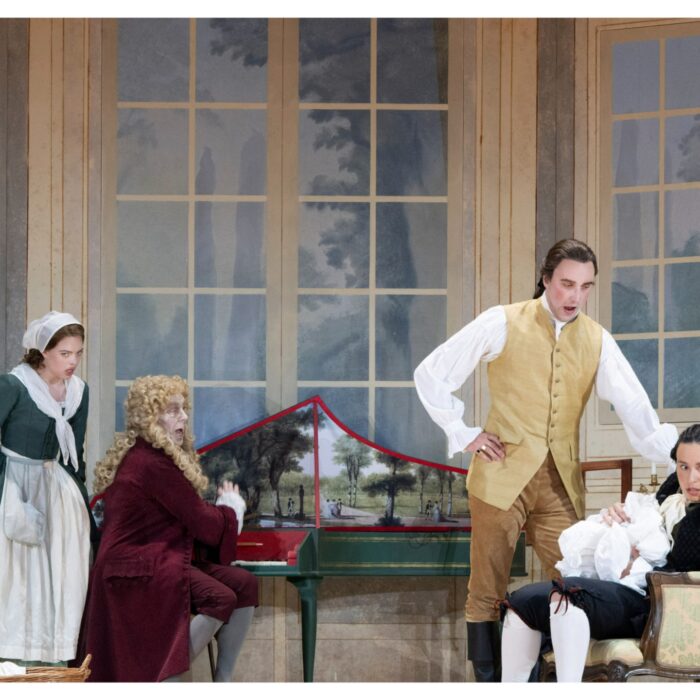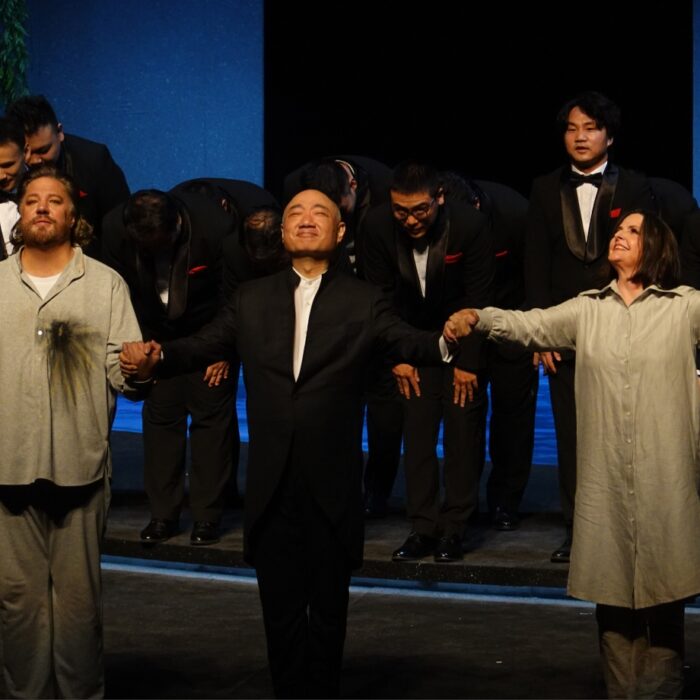
Festival d’Aix-en-Provence 2022 Review: Moïse et Pharaon
Kratzer Creates An Imaginative Spellbinding Production For Today’s Audience
By Alan Neilson(Photo: Monika Ritttershaus)
The initial impressions of the Aix-en-Provence festival’s production of Rossini’s “Moïse et Pharaon” did not bode well. Hearsay reports spoke of a modern day reinterpretation in which the focus was on refugees, and their life in the camps and the perils they face when crossing the Mediterranean.
Productions which seek to politicize an opera, beyond that which is found within the work itself, are rarely successful, as the narrative is often forced into compromises so that the composer and librettist’s conception is subsumed into the director’s vision. Moreover, such an approach is usually accompanied by a one-sided consideration of the subject, tackled on a superficial level and littered with clichés, ensuring that the audience is subjected to blatant and vacuous propaganda. When the curtained rose to reveal a cluttered stage, with a refugee camp on the right side of the stage and the inside of a modern office on the left side, it felt as if these concerns were about to be realized.
Such fears, however, proved premature.
Kratzer’s Masterful Direction
What unfolded was a masterful reading which barely deviated at all from Rossini and his librettist Étienne de Jouy’s masterpiece. Yes, it was updated to include the current refugee crisis, and while the sympathy of the director certainly lay with the refugees, it was no more than Rossini had showed for the Israelites fleeing the Egyptians. Yet, there was no attempt to brow beat the audience, rather this was a descriptive depiction of the crisis, in which the Egyptian’s precipitate the crossing of the Red Sea, illustrating clearly how persecution can lead to a mass movement of people seeking refuge. It had nothing to say about the rights and wrongs of the reception the refugees received in the Promised Land.
Moreover, the director Tobias Kratzer’s presentation was more than just an updating in order to provide relevance to the present day, for it also managed to provide the work with a pleasing dynamic momentum which carried the work forward. Rarely, did the work appear to stop for the express purpose of an aria or a set ensemble, rather Kratzer ensured that there was always something happening. The ballet scene, for example, which from a purely dramatic perspective can be tedious and disruptive, was carefully integrated into the narrative by having Pharaon use it as a means for entertaining his guests, from which he was interrupted by an aide, forcing him to leave his seat and into an animated conversation at the side of the stage. Nor was the chorus allowed to stand around passively. At one point the Israelites are attacked and beaten in their camp by the Egyptian police, which brought into sharp focus the real tensions which existed between the two groups, and amplified the intensity of the presentation.
Imaginative Use Of Video
Kratzer was also happy to take risks to enliven the scenes. It rarely works when an attempt is made to introduce light comedy into a dark, serious work, but this is exactly what Kratzer did with the introduction of Amènophis’ bride-to-be Élégyne, whom we first met via her dating app profile projected onto a screen on the left side of the stage, which had the audience laughing. She then makes an appearance in person, and hammed it up, acting every bit like a spoilt teenager, before storming off in a strop. It was all very amusing, but given the death and suffering which underpins the opera, this could so easily have backfired. It did not. Rather her frivolous and ridiculous behavior acted as a counterweight, and heightened the unfolding tragedy, and illustrated Kratzer’s fine sense of theatre.
Nor did he restrict his use of video. In fact, it was fundamental to his presentation. When Moïse calls upon God to avenge Pharaon’s treachery, a collage of images of drought, deforestation and other man-made environmental disasters is projected onto the stage. It was a powerful moment. There was not a movement, nor a sound from the audience. The disturbing reality was all too close, too real, and brilliantly captured the Egyptians sense of dread and foreboding.
As the opera moved towards its conclusion, the Israelites don life jackets and ready themselves to cross the Red Sea with the Egyptians in hot pursuit. Having crossed, the chorus hurriedly took up positions amongst the audience, and joined them to watch a video of the drowning Egyptians in the deadly waters. Once again, Kratzer successfully brings the reality crashing home.
He sets the conclusion on a beach, no doubt Sharm-el-Sheik, with holiday makers enjoying themselves, catching the sun, whilst in the auditorium the Israelites sang a hymn of praise to God for their victory. It was the same beach from which the Egyptians set out on their fateful journey!
Rainer Sellmaier was responsible for sets and costume design. Although the stage initially appeared disordered and cluttered, this also proved to be incorrect. The juxtaposition of refugee camp next to a plush office actually worked well, drawing attention to the contrast between the Israelites poor living conditions and the comfy lifestyles of the Egyptian court. It also successfully highlighted the power of the bureaucrats, which added another modern dimension to the production; it is the pen-pushers who ensure that the powerful are able to exert their will. The sets for subsequent acts were far more basic so as to open up space for the ballet and choral episodes. All were excellently crafted, and changes were unobtrusively managed.
Everyone was costumed in modern dress, appropriate to their role: Pharaon in a smart dark suit, Sinaïde in smart formal clothing, Anaï in a cheap casual dress and so on. Moïse, however, alone amongst the large cast, was dressed in the traditional clothing we would associate with the biblical era. Looking every inch the religious patriarch, he stood tall in his red and white flowing robes, long hair and beard, with a staff in his hand, and importantly, did not look at all out of place. Rather his appearance magnified his status, and gave credence to his authoritative utterances.
Mention should also be given to Manuel Braun’s superb videos, without which this production would not have achieved its power, immediacy and emotional impact.
Mariotti Holds It All Together
Conductor Michele Mariotti claims not to be a Rossini specialist, but he certainly produced an excellent sound from the Orchestre de l’Opéra de Lyon, eliciting a lively, dramatically focused reading with a pleasing sense of balance. It was a rhythmically strong presentation, but one also able to bring out the score’s delicate detail and textural beauty. However, it was his management of the overall structure which stood out, which displayed an agreeable coherence and momentum, with the large musical forces always kept in check: the big musical numbers in which the full orchestra, soloists and chorus combined were expertly balanced, and achieved without compromising their energy or vibrancy.
He was supported by the Chef de Choeur Richard Wilberforce who generated a fine performance from the Choeur de l’Opéra de Lyon, whose singing was powerful, fresh, lively and spirited, yet always attentive to detail.
Moïse was played by bass Michele Pertusi, who produced a compelling portrait of the patriarch. His dark, resonant voice exudes authority, and was wonderfully suited to the role, to which his slight vibrato added age and wisdom. His movement on stage accentuated the impression, which was slow and restrained, but firm and deliberate.
Bass-baritone Adrian Sâmpetrean made an impressive Pharaon, presenting him as confident, virile and authoritative. He possesses a beautiful voice with a rich, burnished timbre. It is also a versatile voice, able to move freely without any sense of insecurity, which he used intelligently to develop his character, moulding articulate, well-crafted phrases.
One aspect of the work which always holds the attention is the confrontations scenes between the two lead male roles, who are similar, and yet very dissimilar. Both are leaders of their people, both have strong personalities, both roles are written for the bass voice. However, whereas Moïse is a religious figure, secure in his views, immovable, rock-like, Pharaon is a political animal, prone to vacillation and aggression and emotionally more volatile, differences which were wonderfully captured in Pertusi’s and Sâmpetrean’s voices, and perfectly illustrated in the first confrontation at the end of Act one. Moïse standing in the camp surrounded by his people challenges Pharaon, who is determined to keep the Israelites prisoner, and who prefers to communicate via his laptop surrounded by bureaucrat servants. Pertusi’s voice, dark and deep, and laden with gravitas and authority, defiantly but forcefully makes Moïse’s views known, while Sâmpetrean, with his lighter, brighter and more versatile bass-baritone, rages passionately, eventually shoving his laptop aside in frustration.
Vocal Excellence Throughout
Anaï was played by soprano Jeanine De Bique who brilliantly captured her character’s conflicted emotions at being forced to choose between her love for Pharaon’s son Aménophis and the love for her people and her god. It was a feisty performance, in which she voiced her strong emotions energetically and very directly. It was also a high quality performance, one founded on her formidable vocal technique and innate musicality, which she displayed consistently throughout the performance, evidenced by her strong, versatile, well-grounded voice, pleasing passaggio and splendid emotional accenting. Particularly impressive was her final aria “Quelle horrible destinée!” in which she bemoaned her fate, displaying real quality in her ability to coat her lines with emotional strength and honesty.
Pharaon’s son Aménophis, parted by tenor Pene Pati, was imaginatively portrayed as a senior official in, or it may have been as the head of an administrative department concerned with refugees, which had the effect of deepening his role. Pati produced an emotionally strong reading, which convincingly explained his fast changing and extreme reactions. He possesses a pleasingly sweet timbre, which provides the voice with a beautiful sheen, which he exemplified in the opening scene of Act four, in which his sweet toned voice and tenderly wrought phrasing captured his love for Anaï. Although the voice displayed a high level of versatility, there were occasions on which the voice sounded a little stressed as he pushed into its highest reaches, but this had small effect on his overall performance, in what was a lyrically fine presentation. Pati’s voice is a natural for the bel canto repertoire.
Sinaïde was played by mezzo-soprano Vasilisa Berzhanskaya. Having performed the role so successfully at last year’s Rossini festival in Pesaro, it was good to see her in a production in which the character was given a more animated profile, enabling Berzhanskaya to display her fine acting skills. The role is endowed with one of the opera’s showpiece arias “Ah, d’une tendre mère.” Last year she engaged with it head on, producing a bravura vocal display, full of passion, energy and dazzle. This year, she was slightly more circumspect. Her vocal virtuosity topped by her fiery coloratura display and her ability to push the voice easily above the accompanying musical forces were still present, but there was more attention given to nuance of the text, which dampened the carefree exuberance of the presentation. It was an excellent performance, for which she received sustained applause. It was also a presentation which reflected her overall essaying of the role, which exhibited a greater degree of depth and attention given to characterization.
Tenor Mert Süngü showed quality in the role of Moïse’s brother Éliézer. Possessing a well-centered voice, with a fairly homogeneous tone, he produced an emotional and expressive portrait, let down slightly by a little inflexibility in the voice.
Mezzo-soprano Géraldine Chauvet cut a sympathetic figure as Anaï’s mother Marie. Although only a minor role she displayed quality with a well sung performance, in which her colorful pallet caught the attention.
As the High Priest Osiride was bass-baritone Edwin Crossley-Mercer. Dressed as a typical blue-suited marketing executive, or maybe a modern day TV evangelist, he cut a persuasive figure, which he supported with a fine singing performance, in which his pleasing timbre and well-moulded phrasing impressed. He also played the small part of Une Voix Mystérieuse.
Tenor Alessandro Luciano was an effective Aufide, putting in a solid performance.
This was a superb production. It kept the audience thoroughly engaged throughout the evening, and at times was simply spellbinding. The incorporation of video was cleverly integrated into the narrative, and actually raised the dramatic intensity to a level that may have otherwise not been achieved. Along with Mariotti’s sensitive musical direction and a fine cast of singers and dancers, it all worked brilliantly. A video of the production is available on YouTube, for those unfortunate not to have had the opportunity to attend a performance.



